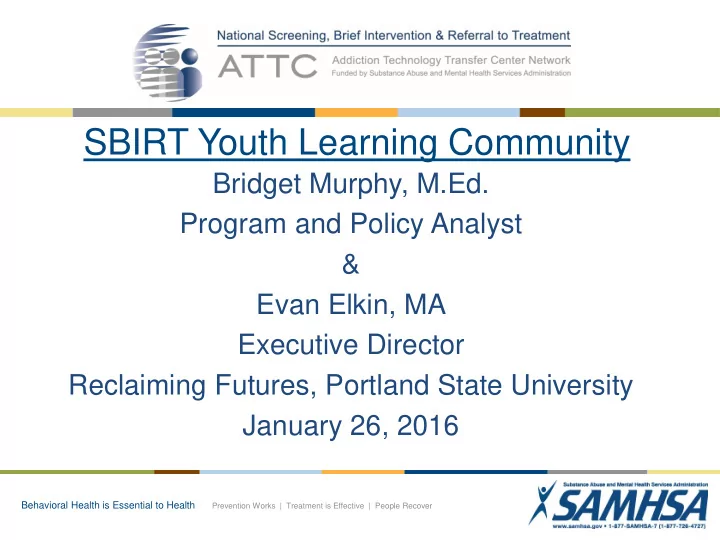

SBIRT Youth Learning Community Bridget Murphy, M.Ed. Program and Policy Analyst & Evan Elkin, MA Executive Director Reclaiming Futures, Portland State University January 26, 2016 Behavioral Health is Essential to Health Prevention Works | Treatment is Effective | People Recover
Learning Objectives • Learners will differentiate between youth SBIRT in juvenile justice settings and adult models. • Learners will identify the Reclaiming Futures SBIRT JJ sites and its implementation setting and characteristics. • Learners will recognize the special implementation considerations relevant for SBIRT JJ.
History of SBIRT and Brief Interventions • The field of Youth SBIRT was launched on the success of adult SBIRT (Harris, 2015) • MET/CBT 5 and the Cannabis Youth Treatment Initiative (Dennis, et. al., 2003) • Dr. Ken Winter’s Teen Intervene Model • SAMHSA SBIRT Study (Brief MI, Mitchel et al. 2012) • Project Chat (20 min MI - D’amico et al., 2008) • Columbia University’s Teen Screen
Polling Question
Fundamental Differences between Adult and Youth versions of SBIRT • Differences between adult and youth drug treatment apply to SBIRT as well • The role of discussing norms with client • Importance of a motivational element • The adolescent brain and the here and now • Importance of family and peers • Different expectations for outcomes? • Duration and setting of BI
Reclaiming Futures Based on Motivational SBIRT JJ Model Interviewing Principles Youth Centered, Strength- based and Collaborative Situates Substance Use and MH Symptoms in the context of Goals Trusts Youth as Key Decision Makers Addresses the role of parent support and attitudes
SBIRTJJ Brief Intervention Sequence Youth Session 2 Youth Session 1 Caregiver Youth with Session Caregiver
Reclaiming Futures SBIRT Initiative • We are grantees in the Conrad N. Hilton Foundation’s multi -year initiative • A public health lens on juvenile justice • Front-end diversion points are key public health interfaces • We view prevention and front end JJ diversion as a parallel processes • The challenge of disentangling risk and need at key decision points • The risk of doing too much and too little
Pause for Questions or Comments
Reclaiming Futures SBIRT JJ Sites
Implementation Descriptions • Vermont – Informal probation diversion - Community Justice Center restorative alternative • New York – Persons In Need of Supervision (PINS) Diversion • North Carolina – School-based arrest diversion • Oregon – Juvenile justice system, front-end, low risk youth (1 st and 2 nd arrest) • Washington – Truancy court diversion program in middle schools • Ohio – Initial trainings have not yet occurred
Staffing • Probation officers/Juvenile counselors • Prevention and behavioral health counselors/clinicians • School resource officers
Training Approach (Portland State University, 2015)
Learning Collaborative Approach • Monthly call/webinar • Three-way information sharing – National Office to grantees – Grantees to National Office – Grantees to grantees
Cross-Site Evaluation • Two external evaluations underway: – Abt Associates – Impact Justice • Youth survey data at three time points: baseline, 3- and 6-months post baseline • Staff survey data at baseline and every 6- months thereafter for as long as he/she is involved with the SBIRT JJ
Cross-Site Evaluation • Domains of interest: – Youth: • Strengths • Substance use • Mental health • Implementation (e.g., training; screenings; brief intervention; referrals) • Youth perception of intervention – Staff • Values and beliefs
Pause for Questions or Comments
Polling Question
Special Considerations for Youth Populations involved in Juvenile Justice • Assume higher baseline levels of use and symptoms • Higher baseline level of trauma and situational distress • Increased pressure to intervene with low and moderate youth • Risk and need are often conflated • Steps in standard public health sequence often skipped
Citations D’Amico, E.J., Miles, J.N.V., Stern, S.A., & Meredith, L.S. (2008). Brief motivational interviewing for teens at risk of substance use consequences: A randomized pilot study in a primary care clinic. Journal of Substance Abuse Treatment, 35, 53-61. Dennis, M.L., Godley, S.H., Diamond, G., Tims, F.M., Barbor, T., Donaldson, J.,. . . . . Funk, R. (2004). The cannabis youth treatment (CYT) study: Main findings from two randomized trials. Journal of Substance Abuse Treatment, 27(3) 197-213. Harris, B. (2015). A review of the research on SBIRT for youth. Presented at the SBIRT Advisory Meeting, March 5-6, 2015. Tampa, Florida. Portland State University (2015). Reclaiming Futures Screening, Brief Intervention & Referral to Treatment: Trainer’s Guide version 1 . Portland, OR: Reclaiming Futures National Office, Portland State University.
Acknowledgements & Disclaimer • Acknowledgements: The authors wish to thank all the staff from the participating sites and the Conrad N. Hilton Foundation for funding this project. • Disclaimer: This report was developed with assistance from funding provided by Conrad N. Hilton Foundation. The views expressed here are the authors, and do not necessarily represent the official policies of the Conrad N. Hilton; nor does mention of trade names, commercial practices, individuals, or organizations imply endorsement by the funding entities.
Recommend
More recommend